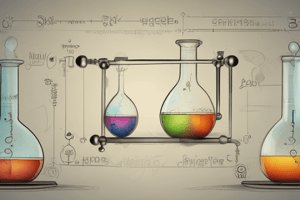Podcast
Questions and Answers
In a balanced chemical equation, why is it important to have the same number of atoms for each element on both the reactant and product side?
In a balanced chemical equation, why is it important to have the same number of atoms for each element on both the reactant and product side?
- To show the law of conservation of mass is obeyed (correct)
- To speed up the reaction process
- To increase the yield of the reaction
- To make the equation look symmetrical
What is the purpose of adding coefficients to each chemical in a chemical equation?
What is the purpose of adding coefficients to each chemical in a chemical equation?
- To change the type of chemical reaction
- To increase the speed of the reaction
- To balance the number of atoms of each element (correct)
- To indicate the state of matter of each chemical
Why is it necessary to count the number of atoms for each element on both the reactant and product side when balancing a chemical equation?
Why is it necessary to count the number of atoms for each element on both the reactant and product side when balancing a chemical equation?
- To verify that the equation is balanced (correct)
- To maintain color balance in the equation
- To calculate the molar mass of the chemicals involved
- To ensure that the reaction is exothermic
In the process of balancing a chemical equation, what should be changed to balance the equation?
In the process of balancing a chemical equation, what should be changed to balance the equation?
Why is it important to understand how to balance chemical equations?
Why is it important to understand how to balance chemical equations?
What is the purpose of putting the coefficient in front of sodium hydroxide in a chemical equation?
What is the purpose of putting the coefficient in front of sodium hydroxide in a chemical equation?
In the reaction between potassium and carbon dioxide, why is a coefficient of 2 placed in front of carbon dioxide?
In the reaction between potassium and carbon dioxide, why is a coefficient of 2 placed in front of carbon dioxide?
What would happen if a coefficient was placed in front of hydrogen gas to balance its atoms?
What would happen if a coefficient was placed in front of hydrogen gas to balance its atoms?
Why is it necessary to conduct a final check of a balanced chemical reaction?
Why is it necessary to conduct a final check of a balanced chemical reaction?
How does balancing the elements in a chemical equation impact the reaction?
How does balancing the elements in a chemical equation impact the reaction?
Why is it important to have a balanced chemical equation?
Why is it important to have a balanced chemical equation?
What does the law of conservation of matter state?
What does the law of conservation of matter state?
What purpose do coefficients serve in a chemical equation?
What purpose do coefficients serve in a chemical equation?
How can you change the number of molecules used in a chemical equation?
How can you change the number of molecules used in a chemical equation?
In a balanced chemical equation, if there are 7 molecules of hydrogen on the reactant side, how many molecules of hydrogen should be on the product side?
In a balanced chemical equation, if there are 7 molecules of hydrogen on the reactant side, how many molecules of hydrogen should be on the product side?
Flashcards are hidden until you start studying
Study Notes
What is a Balanced Chemical Equation?
- A balanced chemical equation is a formula showing the ratio of each of the reactants and each of the products.
- It ensures that each element on the reactant side has an equal amount on the product side.
Characteristics of a Balanced Chemical Equation
- The number of atoms of each element is the same on the reactant and product sides.
- The coefficients (whole numbers) before each chemical are used to balance the equation.
- The coefficients tell how many molecules or moles of each chemical are used in the reaction ratio.
Steps to Balance a Chemical Equation
- Change a word equation into a formula.
- Balance each atom one at a time.
- First, balance any atoms that appear in only a single molecule on the product and reactant side.
- Balance any non-hydrogen or oxygen atoms.
- Balance hydrogen and oxygen atoms.
- Count the atoms on the reactant and product side to check that the equation is balanced.
Important Points to Remember
- When balancing a chemical equation, only change the coefficient numbers, do not change the subscript numbers.
- The order of balancing atoms is not critical, but the order presented is typically the easiest method.
- Balancing a chemical equation often requires trial and error to find the right coefficients.
Examples of Balancing Chemical Equations
Example 1: Sodium and Water React to Form Sodium Hydroxide and Hydrogen Gas
- The unbalanced equation: Na + H2O → NaOH + H2
- The balanced equation: 2Na + 2H2O → 2NaOH + H2
Example 2: Potassium and Carbon Dioxide React to Form Potassium Oxalate
- The unbalanced equation: K + CO2 → K2C2O4
- The balanced equation: 2K + 2CO2 → K2C2O4
Studying That Suits You
Use AI to generate personalized quizzes and flashcards to suit your learning preferences.




